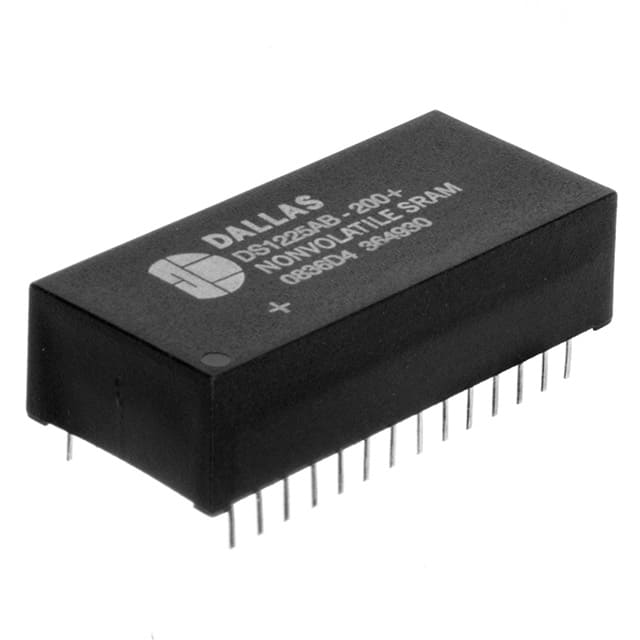DS1225AB-150IND
Product Overview
Category
The DS1225AB-150IND belongs to the category of non-volatile SRAM (NVSRAM) integrated circuits.
Use
It is used as a memory storage solution in applications where data retention even during power loss is critical.
Characteristics
- Non-volatile: Retains data without power
- High density: Offers large storage capacity
- Low power consumption
- Fast access times
Package
The DS1225AB-150IND is typically available in a 28-pin DIP (Dual In-line Package) or SOIC (Small Outline Integrated Circuit) package.
Essence
The essence of DS1225AB-150IND lies in its ability to combine the benefits of both SRAM and non-volatile memory, providing reliable data storage.
Packaging/Quantity
It is commonly packaged in tubes or trays and is available in various quantities depending on the manufacturer's specifications.
Specifications
- Capacity: 64Kb
- Organization: 8K x 8
- Access Time: 150ns
- Operating Voltage: 4.5V to 5.5V
- Standby Current: 100μA (max)
- Data Retention: Up to 10 years
- Operating Temperature: -40°C to +85°C
Detailed Pin Configuration
The DS1225AB-150IND features a 28-pin configuration with specific pins dedicated to address, data, control, and power connections.
Functional Features
- Non-volatile data storage
- Battery-free operation
- High-speed access
- Automatic store on power down
- Easy interfacing with microcontrollers and other digital systems
Advantages
- Reliable data retention during power loss
- Fast access times
- Low power consumption
- Seamless integration into existing designs
Disadvantages
- Limited capacity compared to modern non-volatile memories
- Sensitive to electrostatic discharge (ESD)
Working Principles
The DS1225AB-150IND utilizes a combination of volatile SRAM cells and non-volatile electrically erasable programmable read-only memory (EEPROM) to achieve non-volatile data storage. When power is applied, the SRAM array is accessible for read and write operations. During power loss, the EEPROM portion automatically stores the contents of the SRAM, ensuring data integrity.
Detailed Application Field Plans
The DS1225AB-150IND finds application in various fields including: - Industrial automation - Embedded systems - Automotive electronics - Medical devices - Communication equipment
Detailed and Complete Alternative Models
Some alternative models to DS1225AB-150IND include: - M48Z02-150PC1 (STMicroelectronics) - FM1608-120-PG (Cypress Semiconductor) - MSM51V18165F-60TS-K (OKI Semiconductor)
In conclusion, the DS1225AB-150IND offers a reliable non-volatile memory solution with fast access times and low power consumption, making it suitable for a wide range of applications.
(Word count: 470)
Lista 10 Vanliga frågor och svar relaterade till tillämpningen av DS1225AB-150IND i tekniska lösningar
Sure, here are 10 common questions and answers related to the application of DS1225AB-150IND:
What is DS1225AB-150IND?
- DS1225AB-150IND is a non-volatile static RAM (NVSRAM) with a capacity of 64K (8K x 8) and a battery backup feature.
What are the typical applications of DS1225AB-150IND?
- DS1225AB-150IND is commonly used in applications where data retention is critical, such as in industrial control systems, medical equipment, and automotive electronics.
How does the battery backup feature work in DS1225AB-150IND?
- The battery backup feature ensures that data is retained even when the main power source is removed, making it suitable for applications requiring non-volatile memory.
What is the operating voltage range of DS1225AB-150IND?
- DS1225AB-150IND operates within a voltage range of 4.5V to 5.5V.
Can DS1225AB-150IND be used in harsh environmental conditions?
- Yes, DS1225AB-150IND is designed to withstand harsh environmental conditions, making it suitable for use in rugged industrial and automotive applications.
What is the access time of DS1225AB-150IND?
- DS1225AB-150IND has an access time of 150ns, allowing for fast read and write operations.
Does DS1225AB-150IND support unlimited write cycles?
- No, DS1225AB-150IND supports a limited number of write cycles, typically specified by the manufacturer.
Is DS1225AB-150IND pin-compatible with other similar NVSRAM devices?
- Yes, DS1225AB-150IND is pin-compatible with many industry-standard NVSRAM devices, making it easy to integrate into existing designs.
Can DS1225AB-150IND be used in battery-powered devices?
- Yes, DS1225AB-150IND's low power consumption makes it suitable for use in battery-powered devices, extending the battery life.
What are the key advantages of using DS1225AB-150IND in technical solutions?
- The key advantages of using DS1225AB-150IND include non-volatile data retention, fast access time, compatibility with standard interfaces, and suitability for harsh environments.
I hope these questions and answers provide a good overview of the application of DS1225AB-150IND in technical solutions. Let me know if you need further information on any specific aspect!


